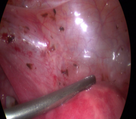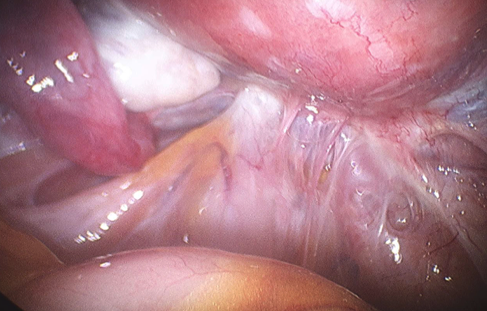Our Treatments
|
We consider the needs of each woman when planning treatment, including her age, symptoms, medical history, fertility and preferences.
We encourage you to stay in contact with us regularly by phone or email or by making an appointment so we can continue to your needs and optimise your health. |
"We believe in doing everything possible to preserve a woman’s ovaries.” |
Symptom Management
It is important that women take an active part in their treatment.
Pain caused by endometriosis can be quite severe and cause major disruption to a woman’s life.
If pain during a period is the only problem, taking the pill (oral contraceptive pill) to avoid having periods may be all that is required. This does not remove the endometriosis, but it can make minor endometriosis inactive. There are many pill preparations available. Your doctor and nurse coordinator can help you choose what is best for you and monitor your progress.
For other types of pain (for example pain during or after intercourse, bowel pain), specific pain relieving drugs may be needed.
Symptom Management - Drug Free Options
Stress/Management & Pain
Diet/Herbal Preparations
It is important that women take an active part in their treatment.
Pain caused by endometriosis can be quite severe and cause major disruption to a woman’s life.
If pain during a period is the only problem, taking the pill (oral contraceptive pill) to avoid having periods may be all that is required. This does not remove the endometriosis, but it can make minor endometriosis inactive. There are many pill preparations available. Your doctor and nurse coordinator can help you choose what is best for you and monitor your progress.
For other types of pain (for example pain during or after intercourse, bowel pain), specific pain relieving drugs may be needed.
Symptom Management - Drug Free Options
- Women who choose a drug-free treatment option can enjoy additional health benefits and feel better overall.
- studies show that women who do one hour of exercise three times per week can reduce their pain and maximise their enjoyment of life
- studies show that women who lose weight after a diagnosis can reduce their pain
Stress/Management & Pain
Diet/Herbal Preparations
- please consult a naturopath/herbalist - Meredith O'Loughlin - www.springtcm.com
Hormonal Treatments
Hormonal treatments are highly effective in improving symptoms while a woman is using them.
Pill (Oral Contraceptive Pill)
Zoladex Abdominal Implant (GnRH Analogues Goserelin)
Please note: Treatment is limited to six months – thinning of the bones may occur but this is reversible once you stop taking the drug
Mirena IUD (Intra-Uterine Contraceptive Device)
Depo Provera (Progestagen Therapy)
Hormonal treatments are highly effective in improving symptoms while a woman is using them.
Pill (Oral Contraceptive Pill)
- taking the pill to avoid having periods may be all that is required
- can be combined with other hormone altering drugs to reduce endometriosis activity (for example Letrozole)
Zoladex Abdominal Implant (GnRH Analogues Goserelin)
- is an effective treatment for endometriosis
- is often used before and/or after surgery (and ART – Assisted Reproduction Therapy) to suppress endometriosis activity
- results in temporary reduction in the release of oestrogen by the ovaries, reducing pain and size of endometriosis deposits
- can cause side effects similar to menopausal symptoms (due to the low Oestrogen levels while using it) and can include headaches, hot flushes, muscle pain and insomnia (taking 'add back' oestrogen tablets can help)
- causes most women to pause having a period while having this treatment
Please note: Treatment is limited to six months – thinning of the bones may occur but this is reversible once you stop taking the drug
Mirena IUD (Intra-Uterine Contraceptive Device)
- releases small amounts of progestagens into the uterine lining and surrounding tissue
- is effective in reducing endometriosis pain in some women
- can be removed easily if the woman decides she wants to become pregnant
- can be used in combination with Minipill for further symptom management
Depo Provera (Progestagen Therapy)
- is a three-monthly intra-muscular injection
- can be effective in controlling symptoms long-term
- causes side effects including bloating, tiredness, depression and irregular bleeding
- is not suitable for women trying to become pregnant
- oral progestogens including Minipill/Dinogest
Surgical Options
“You have the best chance of successfully removing endometriosis if treated by an expert surgeon – at Ballarat Endo Clinic all surgeons are specialists, trained to diagnose and treat endometriosis.”
- Dr Russell Dalton
1. Laparoscopic Surgery
“Our specialists strongly believe it is almost always possible to remove cysts containing endometriosis and to preserve the ovary.” Surgical Excision of Endometriosis
Our surgeons aim to remove as much visible endometriosis as is safely possible. There are varied techniques used to achieve this. Endometriosis lesions can be concentrated in one area and are generally more able to be fully excised than a 'Miliary Pattern' of endo - a generalised sprayed pattern throughout the pelvis. 'Miliary Pattern' endo may benefit from on-going hormonal treatments. www.zoladex.com Endometriosis nodules that have grown onto the bowel requires skilled surgeons to remove the lesion and prevent damage to the bowel itself. A bowel specialist surgeon is involved in this type of surgery and you may be asked by your Gynaecologist to attend an appointment with Mr Bruce Stewart for further discussion about planned surgery. www.ballaratspecialistclinic.com.au |
Example of Nodular Endo
Example of Miliary Endo
|
Removal of Cysts
Numerous studies show clearly that laparoscopic surgery is the best way to treat endometriosis. It is a minor, relatively safe procedure performed under anaesthesia in a day hospital. Advanced video systems allow a magnified, close up view of pelvic organs.
Benefits
Numerous studies show clearly that laparoscopic surgery is the best way to treat endometriosis. It is a minor, relatively safe procedure performed under anaesthesia in a day hospital. Advanced video systems allow a magnified, close up view of pelvic organs.
Benefits
- higher cure rates; small incision
- minimises scarring, pain and recovery time
- a skilled surgeon can thoroughly check all pelvic organs for any sign of endometriosis and remove it
- tissues are handled gently
- prevents drying of the delicate lining of the pelvis
- surgery is performed more precisely than with open techniques
Hormonal Replacement Therapy (HRT) & Endometriosis
Many women who have had surgery to remove an ovary choose to use HRT (oestrogen) to ease the symptoms associated with menopause.
HRT may stimulate any residual endometriosis tissue in some women, causing an increase in pain and endometriosis symptoms. To deal with this problem there are a number of options:
Many women who have had surgery to remove an ovary choose to use HRT (oestrogen) to ease the symptoms associated with menopause.
HRT may stimulate any residual endometriosis tissue in some women, causing an increase in pain and endometriosis symptoms. To deal with this problem there are a number of options:
- reduce the dose of oestrogen to the absolute minimum required
- add progestagens to the existing treatment to reduce the activity of any residual endometriosisuse Tibolone instead of oestrogen as HRT – it does not stimulate endometriosis tissue and breast tissue in the same way that oestrogen does.
Infertility Treatments
Infertility related to endometriosis can be managed by laparoscopic surgery, superovulation (OI), intrauterine insemination (IUI) or in-vitro fertilisation (IVF). > More about ART
please note Laparoscopic surgery for severe endometriosis may take several hours and in some cases it may be necessary to undertake a second operation after drug treatment (such as Zoladex) to reduce the size and activity of the endometriosis (possible removal of part of the lower bowel, but in experienced hands recovery is straightforward and not usually a problem.
Infertility related to endometriosis can be managed by laparoscopic surgery, superovulation (OI), intrauterine insemination (IUI) or in-vitro fertilisation (IVF). > More about ART
please note Laparoscopic surgery for severe endometriosis may take several hours and in some cases it may be necessary to undertake a second operation after drug treatment (such as Zoladex) to reduce the size and activity of the endometriosis (possible removal of part of the lower bowel, but in experienced hands recovery is straightforward and not usually a problem.
|
2. Open Surgery
Occasionally, in the case of severe endometriosis, it may be necessary to perform open surgery. Removal of an Ovary/Ovaries
Hysterectomy
Combined Surgery In severe endometriosis cases, a woman may need a combined surgery, which includes removal of a small section of the bowel. Ballarat Endometriosis Clinic uses specialist colorectal surgeon, Mr Bruce Stewart to perform this surgery www.ballaratspecialistclinic.com.au A urology team is also available if the urinary tract is involved (ie bladder, ureters) A bowel prep medication may be recommended the day before complex surgery involving the bowel. This medication, called Picolax, helps to minimise the risk of infection and bowel injury, as well as helping the surgeon mobilize the bowel during the operation. The endometriosis surgery near the bowel may include gently separating the endometriosis away from the bowel, without removing any part of the bowel itself. A disc excision of the bowel may be performed for endometriosis that has grown through the wall of the bowel. This is a localised area and the bowel wall is repaired at the time of surgery. For larger affected areas, a segmental bowel resection may be needed, where a section of the bowel is removed and the bowel is rejoined |
Example of an Adhesion
|




